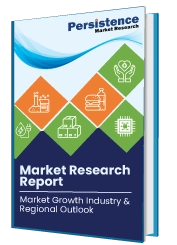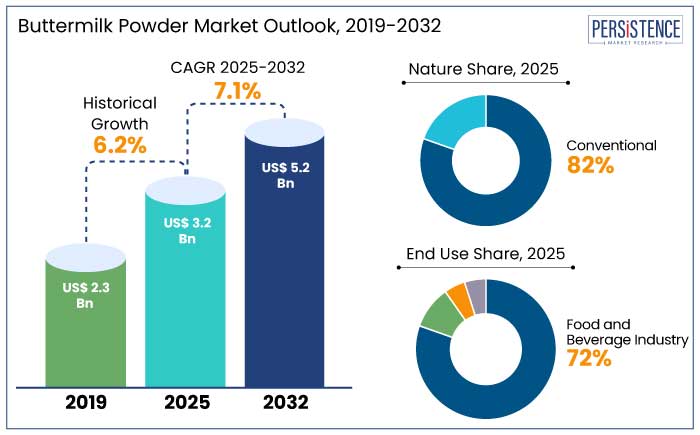ID: PMRREP12508| 182 Pages | 24 Jun 2025 | Format: PDF, Excel, PPT* | Food and Beverages

The global buttermilk powder market size is likely to be valued at US$ 3.2 Bn in 2025 and is estimated to reach US$ 5.2 Bn by 2032, growing at a CAGR of 7.1% during the forecast period 2025-2032.
Buttermilk powder is recognized for its high protein and essential nutrient content, making it highly preferred in functional foods and beverages. This demand is fueled by health-conscious consumers and the rising popularity of fitness-centric products.
Powdered buttermilk is widely used in the production of bakery products owing to its flavor-enhancing properties and ability to enhance the texture and shelf life of baked goods.

Key Highlights of the Industry
|
Market Attributes |
Key Insights |
|
Buttermilk Powder Market Size (2025E) |
US$ 3.2 Bn |
|
Projected Market Value (2032F) |
US$ 5.2 Bn |
|
Global Market Growth Rate (CAGR 2025 to 2032) |
7.1% |
|
Historical Market Growth Rate (CAGR 2019 to 2023) |
6.2% |
The North America buttermilk powder market is estimated to hold a share of 38.1% in 2025. The region has a robust dairy production infrastructure that supports large-scale manufacturing of buttermilk powder. It also benefits from novel dairy processing technologies and efficient distribution networks. The U.S. buttermilk powder market forms the backbone of North America's dominance, driven by its strong dairy sector and widespread use in bakery, confectionery, and ready-to-eat foods. The product is valued for its emulsifying properties, rich flavor, and clean-label appeal. Increasing demand from the foodservice industry and a rise in protein-fortified food trends further fuel its steady consumption across the country. For instance,
Rising awareness of functional food products and their health benefits in the region is driving demand for buttermilk powder as a protein-rich ingredient in various food applications. Consumers in North America are seeking clean-label products that are free from artificial additives and preservatives, leading to a surging demand for buttermilk powder as a natural ingredient.
Europe’s buttermilk powder market is gaining traction due to the region's deep-rooted dairy traditions and growing consumer preference for natural, minimally processed ingredients. Countries like Germany, France, and the Netherlands lead in dairy innovation and export, fostering demand for versatile dairy derivatives like buttermilk powder. The rise of clean-label food trends across Europe has encouraged manufacturers to reformulate processed foods with natural ingredients, boosting the use of buttermilk powder in bakery, sauces, and ready-meal applications. Additionally, EU regulations promote transparency and health-focused labeling, further aligning with the functional and natural appeal of buttermilk powder. The product’s high protein and emulsifying qualities make it ideal for food and beverage producers seeking to meet both regulatory and consumer expectations.
Conventional is projected to hold a share of 82% in 2025. Conventional buttermilk powder is more affordable to produce compared to its organic alternatives. This is supported by less stringent production requirements and higher yields from conventional dairy farms.
Manufacturers in the food and beverage industry prefer conventional buttermilk powder for applications in baked goods, dairy products, and snacks due to its consistent availability and competitive pricing.
Conventional buttermilk powder undergoes standardized processing techniques that ensure longer shelf life, better solubility, and enhanced emulsification properties. This makes it ideal for large-scale food production.
The food and beverage industry is anticipated to hold a share of 72% in 2025. Powdered form of buttermilk is a popular ingredient in baked goods owing to its ability to enhance flavor, texture, and shelf life. It is widely used in dairy-based beverages, smoothies, and ready-to-eat snacks due to its nutritional value and ease of incorporation.
The food and beverage industry is incorporating functional and clean-label ingredients. Buttermilk powder is valued for its natural composition and functional properties. This includes emulsification, thickening, and flavor enhancement.
Powdered buttermilk is extensively used in instant food mixes, soups, sauces, and dressings owing to its longer shelf life and easy storage. It is gaining immense popularity as a nutritional ingredient in health-focused food and beverage products.
Business to business (B2B) is predicted to hold a share of 83% in 2025. B2B sales enable food manufacturers and processors to procure buttermilk powder in bulk, leading to cost savings and operational efficiencies. For instance,
Restaurants, bakeries, and catering services are key consumers of buttermilk powder, particularly in regions where baked goods and dairy-based menu items are in high demand. Business to business distribution channels are optimized for large-scale transactions and have well-established supply chains that ensure timely delivery and consistent product quality. For example,
B2B suppliers often offer customized solutions that cater to the specific requirements of manufacturers. This includes providing tailored packaging, private labelling, and formulation assistance.
Potential growth in the global buttermilk powder industry is predicted to be driven by increased use in infant nutrition, sports supplements, and health-focuses snacks. Technological developments in processing and packaging of buttermilk powder products are also likely to improve visible appeal.
Apart from its nutritional value, buttermilk powder has excellent functional qualities like texture enhancement and emulsification. Natural emulsifiers, such as proteins and phospholipids, aid in solidifying fat in the mixture and guaranteeing that important fatty acids are distributed evenly. This characteristic is especially significant for hydrolyzed formulas intended for babies with sensitive digestive systems.
Nestlé NAN Supreme Pro, for example, uses buttermilk powder that is high in phospholipids to give it a creamy mouthfeel and better absorption of nutrients, making it more like human breast milk. Additionally, buttermilk powder's subtle, creamy flavor improves the taste of baby formulas and increases newborns' acceptance of it.
The buttermilk powder market growth was steady at a CAGR of 6.2% during the historical period from 2019 to 2023. The industry witnessed moderate growth owing to rising demand for dairy-based ingredients in the bakery and confectionery sectors. Increased popularity of functional food and clean-label products contributed to this growth.
Food and beverage industry's innovation in snack formulations and health-conscious products further drove demand for buttermilk powder. Rising demand for high-protein and low-fat ingredients in health-focused food formulations spiked sales.
The forecast period is likely to witness an increasing focus on sustainability and clean-label ingredients in the industry. Growth of e-commerce distribution channels is likely to enhance the availability of buttermilk powder.
Buttermilk powder is used as a key ingredient in dairy-based drinks such as smoothies, protein shakes, and flavored milk products to enhance texture and nutritional value. Its ability to blend well and improve the stability of formulations makes it an ideal choice for manufacturers.
Consumers are seeking high-protein and low-calorie snacks made from dairy ingredients where buttermilk powder is used for its nutritional profile and creamy flavor. Health bars, savory snacks, and cheese-based products now frequently incorporate buttermilk powder as an ingredient.
Buttermilk powder is a key ingredient in flavored yogurt, probiotic beverages, and fermented dairy snacks due to its ability to improve mouthfeel and enhance flavor. Demand for fermented dairy products, which promote gut health, has further fueled the adoption of buttermilk powder.
Buttermilk powder has a shelf life of 12 to 24 months when stored under proper conditions, compared to liquid buttermilk, which spoils within 7 to 10 days when refrigerated. This difference in storage duration minimizes the risk of spoilage and reduces wastage throughout the supply chain.
Powdered buttermilk is shelf-stable and can be transported and stored without refrigeration, unlike liquid dairy products that require continuous refrigeration. This characteristic decreases logistics costs, especially for international shipping. For example,
Long shelf life makes buttermilk powder suitable for stockpiling in emergency food reserves and disaster relief supplies. Food manufacturers also benefit by maintaining longer production cycles without concerns over ingredient spoilage. For example,
Individuals with lactose intolerance are likely to experience digestive issues after consuming dairy products like buttermilk powder. This widespread condition makes dairy products less appealing to large segments of the global market. For example,
Consumers with lactose intolerance are opting for alternatives like lactose-free dairy products, plant-based milks, and other dairy substitutes. Rising cases of lactose intolerance have resulted in a high demand for lactose-free dairy products. This shift in consumer preference can detract from the growth of traditional dairy powders like buttermilk.
Buttermilk powder is lightweight, compact, and does not require refrigeration, making it convenient for both consumers and commercial users. The powder form is also less messy and easier to measure accurately, making it ideal for foodservice applications and industrial production lines.
Buttermilk powder can be easily reconstituted with water to serve as a substitute for liquid buttermilk in recipes for baked goods, pancakes, waffles, and marinades. Its tangy flavor profile makes it a valuable ingredient in seasoning blends, sauces, and dairy-based snacks.
Buttermilk powder is often marketed as a natural and minimally processed ingredient, aligning with clean-label and health-conscious consumer preferences. It is also used in protein-enriched snack formulations, appealing to the high demand for functional foods. For example,
Spray drying is the most commonly used method for converting liquid buttermilk into powder. Advances in spray drying technology have led to energy-efficient systems, decreasing production costs and improving product consistency. New spray drying equipment allows better control over temperature and humidity, leading to a product with finer texture, improved solubility, and superior flavor retention. For example,
Microencapsulation techniques are being used to protect sensitive ingredients like vitamins, probiotics, and bioactive compounds in buttermilk powder. By coating buttermilk powder with a protective layer, manufacturers can improve its stability, shelf life, and functionality. This is particularly useful in the production of health supplements and fortified foods.
Innovations in packaging materials, like vacuum-sealed bags and moisture-resistant pouches, have improved the shelf life of buttermilk powder. This further helps manufacturers to maintain product freshness for longer periods. For example,
Companies in the buttermilk powder market are offering lactose-free buttermilk powder or low-fat variants to cater to the high demand for lactose-free products. They are also adopting eco-friendly practices in their production processes to meet the demand for sustainability.
Manufacturers are diversifying their product offerings by introducing flavored or fortified buttermilk powder with added nutrients to appeal to health-conscious customers. This can help companies to attract specific consumer segments seeking functional dairy products.
Businesses are partnering with food and beverage manufacturers to incorporate buttermilk powder into a wide range of products. By broadening their reach in food applications, they can access new markets and diversify their revenue sources.
The market is anticipated to reach a value of US$ 5.2 Bn by 2032.
Unopened buttermilk powder has a shelf life of 3 to 5 years.
North America is anticipated to emerge as the leading region with a share of 38.1% in 2025.
Prominent players in the market include Hoogwegt Group, Continental Dairy Facilities, LLC, and All American Foods.
The market is predicted to witness a CAGR of 7.1% throughout the forecast period.
|
Attributes |
Detail |
|
Forecast Period |
2025 to 2032 |
|
Historical Data Available for |
2019 to 2023 |
|
Market Analysis |
US$ Billion for Value |
|
Key Regions Covered |
|
|
Key Market Segments Covered |
|
|
Key Companies Profiled in the Report |
|
|
Report Coverage |
|
|
Customization and Pricing |
Available upon request |
By Nature
By End Use
By Distribution Channel
By Region
Delivery Timelines
For more information on this report and its delivery timelines please get in touch with our sales team.
About Author